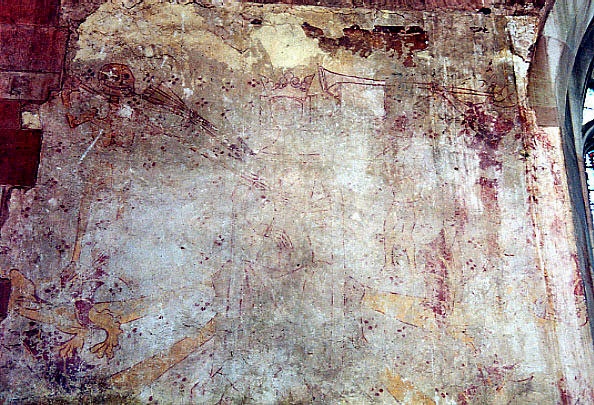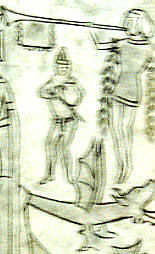Alveley, Shropshire (†Hereford) c.14
The Seven Deadly Sins

Only the upper part, very faded but with some very interesting details, survives. In the centre stands a female figure, faintly etched now, but crowned and apparently wearing one of the square headresses popular in the period when she was painted. EW Tristram¹ thought the figure was naked, but I doubt this. She seems, rather, to be wearing an elegant gown with a straight-cut neckline at collarbone level, tight sleeves and close-fitting bodice with a tight, very narrow waist. Her long-fingered hands are aristocratically poised in front of her and a cloak or train hangs from her shoulders. Garments like these were the last word in fashion among aristocratic ladies of the period and there are many examples in manuscript illustration.
Yellow creatures, reminiscent of lizards with large splayed saurian feet, issue from her lower body – one on the left is the clearest, but there were probably once six of them, representing the Deadly Sins other than Pride, which this woman embodies.
In this, the figure most closely resembles the example at Raunds, although this painting is earlier. An equally important resemblance to Raunds lies in the grinning skeleton at the upper left, who represents Death, aiming a spear at the breast of the woman and holding what looks like a bundle of arrows in his left hand.

There is, so far as I know, no existing comparable example of the figure blowing a long trumpet at the upper right of the photograph. At Bardwell in Suffolk though, and long gone now, there was once a Tree of the Seven Deadly Sins, contemporary with this example, which included three trumpeters preceded by a smaller figure playing bagpipes². Something very similar may be here – a small, out-of-scale, figure in a pointed hat between the trumpeter and Pride – only his legs and part of his hat are now visible on the wall. This detail is taken from an old drawing in the church, framed under glass and very difficult to reproduce clearly, but the figure in question might well be playing a bagpipe – sometimes seen in courtly scenes as an accompanying instrument for dancing, but very often associated with peasant or lower-class merrymaking and explicitly calling attention, because of its shape, to its status as a phallic symbol. Here, along with the ironic inclusion of the trumpeter blaring in Pride’s ear, it may have been considered a suitably debunking comment on the puffed-up self-importance characterising the primary Deadly Sin.
This intriguing treatment of the Seven Deadly Sins is in the south aisle of the church. To the left of it are the remains of an Annunciation and Visitation, both now barely visible, and a painting described as the Fall of Man, now effectively indecipherable. Alveley also has a rare medieval altar-frontal, away for restoration when I visited.
¹Tristram III, p. 133
²Tristram III, p. 137
† in page heading = Diocese